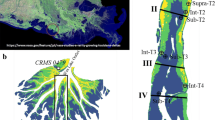Abstract
Nitrogen and phosphorus cycling in a eutrophic Louisiana freshwater lake system (Lac des Allemands) was studied. Nutrients from runoff entering the lake, as well as sediment-interstitial and lake water nitrogen and phosphorus fractions, were measured seasonally. Sedimentation rates in the lake were determined using137Cs dating.
Phosphorus levels in the lake were found to be largely dependent on concentrations in the incoming bayou water from upland drainage. Lake water concentrations appear to respond to fluctuations in incoming waters. Laboratory equilibrium studies showed bottom sediments in the lake are a major sink for the incoming dissolved orthophosphate phosphorus. Total nitrogen concentrations in the lake water generally exceeded incoming runoff concentrations, suggesting fixation by the large blue-green algae population in the lake as being the major source of nitrogen to the system.
Sedimentation ranged from 0.44 cm/year to 0.81 cm/year, depending on the proximity to the inlet bayous. Even though the lake is eutrophic the sediment served as a buffer by removing large amounts of carbon, nitrogen, and phosphorus through sedimentation processes. Carbon, nitrogen, and phosphorus were accumulating in the sediment at rates of 60, 7.1, and 1.1 g/m2/year, respectively.
The water quality of the lake is likely to continue to decline unless measures are taken to reduce municipal, industrial, and agricultural inputs of phosphorus into the lake.
Similar content being viewed by others
Literature cited
Butler, T. J. 1975. Aquatic metabolism and nutrient flux in a southern Louisiana swamp and lake system. Master's thesis, Louisiana State University, Baton Rouge.
Day, J. W., Jr., T. Butler, and W. Conner. 1977. Productivity and nutrient export studies in a cypress swamp and lake system in Louisiana.Est. Proc. 2:255–269.
DeLaune, R. D., W. H. Patrick, Jr., and R. J. Buresh. 1978. Sedimentation rates determined by137Cs dating in a rapidly accreting salt marsh.Nature 275:532–533.
Keeney, D. R. 1974. Protocol for evaluating the nitrogen status of lake sediments. EPA-660/3-73-024.
Kemp, G. P. 1978. Agricultural runoff and nutrient dynamics of a swamp forest in Louisiana. Master's thesis, Louisiana State University, Baton Rouge.
Lantz, K. 1970. An ecological survey of factors affecting fish production in a Louisiana natural lake and river. Louisiana Wildlife and Fisheries Commission Bulletin 6. 92 pp.
Lee, G. F., W. C. Sonzogni, and R. D. Spear. 1976. Significance of oxic vs. anoxic conditions for Lake Mendota sediment phosphorus release. Pages 363–369in Golterman (ed.), Interactions between sediments and freshwater. Junk and Pudoc.
Lotse, E. G. 1973. Phosphate retention by lake sediments. Maine University Land and Water Resources Center Project completion report.
Louisiana Dept of Natural Resources. 1980. Louisiana water quality management plan, Appendix B: Barataria Basin plan, phase II. Report prepared by Water Resources Engineers for Louisiana Department of Natural Resources, Baton Rouge, LA.
Mortimer, C. H. 1941. The exchange of dissolved substances between mud and water in lakes.Journal of Ecology 29:280–329 and 30:147–201.
Patrick, W. H., Jr., and I. C. Mahapatra. 1968. Transformation and availability to rice of nitrogen and phosphorus in waterlogged soils.Advances in Agronomy 20:323–358.
Patrick, W. H., Jr., and K. R. Reddy. 1976. Nitrification-denitrification reactions in flooded soils and water bottoms: dependence on oxygen supply and ammonium diffusion.Journal of Environmental Quality 5:469–472.
Pennington, W., R. S. Cambroy, and E. M. Fisher. 1973. Observations on lake sediments using fallout137Cs as a tracer.Nature 242:324–326.
Phillips, R. E., K. R. Reddy, and W. H. Patrick, Jr. 1978. The role of nitrate diffusion in determining the order and rate of denitrification in flooded soil. II. Theoretical analysis and interpretation.Soil Science of America Journal 42:272–278.
Reeburg, W. S. 1967. An improved interstitial water sampler.Limnology and Oceanography 12:163–165.
Spear, R. D. 1970. The release of phosphorus from lake sediments. PhD dissertation, University of Wisconsin, Madison.
Strickland, J. D. H., and T. R. Parsons. 1972. A manual of seawater analysis. Bulletin of the Fisheries Research Board of Canada 167, 3rd edn. Ottawa. 311 pp.
US Environmental Protection Agency. 1979. Methods for chemical analysis of water and wastes. Environmental Monitoring and Support Laboratory, Office of Research and Development, Cincinnati, EPA-600-4-79-020.
Vollenweider, R. A. 1969. Possibilities and limits of elementary models concerning the budget of substances in lakes.Archives of Hydrobiology 66:1–36.
Author information
Authors and Affiliations
Rights and permissions
About this article
Cite this article
Stow, C.A., De Laune, R.D. & Patrick, W.H. Nutrient fluxes in a eutrophic coastal Louisiana freshwater lake. Environmental Management 9, 243–251 (1985). https://doi.org/10.1007/BF01867080
Issue Date:
DOI: https://doi.org/10.1007/BF01867080




